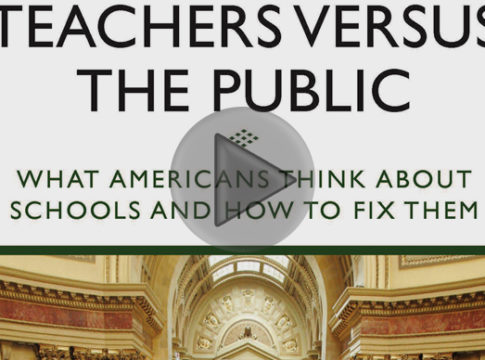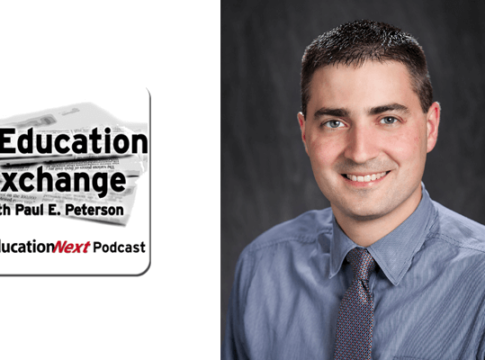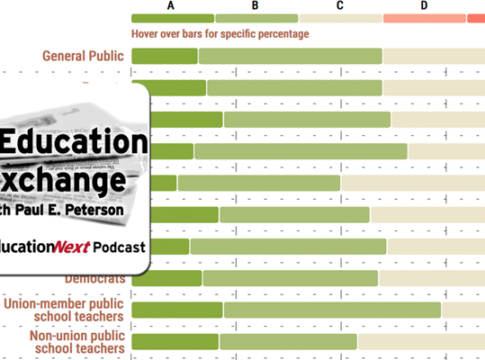The following is an excerpt from Teachers Versus the Public, a new book by Paul E. Peterson, Michael Henderson and Martin R. West for Brookings Institution Press.
How widespread is teacher opposition to rigorous teacher evaluations, school accountability, teacher pension reform, merit pay, charter schools, school vouchers, and other items on the reform agenda? How does teacher opinion compare with that of the general public? Are they essentially in agreement on the most important issues? Or is there a wide gap between the views that teachers hold and those held by parents, taxpayers, and the public as a whole? And how does the stance taken by teachers compare with the positions held by African American and Hispanic citizens, who arguably have the most to gain from improvements to the country’s most troubled schools? If quality education is the civil rights issue of our time, as Secretary Duncan has said, then it is worth knowing whether teachers and these minority groups are on the same page.
 The Chicago teachers union strike of 2012 confirms that teacher organizations have the clout to shape education policy. The routine participation of these organizations in the collective bargaining process gives teachers a special seat at the policymaking table available to no other group involved in school governance. Furthermore, the collection of union dues directly from teacher paychecks, a common practice in many school districts, augments teacher power by generating resources that can be used in political campaigns for school board, state, and national elections.
The Chicago teachers union strike of 2012 confirms that teacher organizations have the clout to shape education policy. The routine participation of these organizations in the collective bargaining process gives teachers a special seat at the policymaking table available to no other group involved in school governance. Furthermore, the collection of union dues directly from teacher paychecks, a common practice in many school districts, augments teacher power by generating resources that can be used in political campaigns for school board, state, and national elections.
But does the disproportionate power of teachers in education policymaking cause problems for democratic governance? If teachers and the public have a common vision, there is no reason to fear teacher influence in the politics of American education. Indeed, if that is the case, the public can safely rely on teacher power to promote common goals. But if the divisions of opinion between teachers and the public are deep, not just in Chicago but throughout the country, then the conflict between Karen Lewis and Rahm Emmanuel may have more general import.
For Randi Weingarten, the answers to these questions are obvious: “Parents, the public, and teachers share the same beliefs about the importance of good teaching and strong neighborhood schools. For all who care about kids, the challenge is to act on this shared vision.” Karen Lewis is no less insistent that she and her union are fighting for everyone, not just for teachers. “The fight is not about Karen Lewis,” she shouted to her cheering followers. “This fight is about the very soul of public education—not only in Chicago but everywhere.” In her view, “Our children are not numbers on a spreadsheet: When you come after our children, you come after us.” [1]
But union leaders, when issuing public statements, may make claims about public support that are not altogether justified. In the aftermath of the teacher strike, the National Opinion Research Center (NORC), a respected polling firm associated with the University of Chicago, administered a survey to a cross-section of the Chicago public. Nearly two-thirds of respondents favored the expansion of charter schools within the city, while less than one-third opposed the idea. Nearly three-fourths favored merit pay for teachers, and almost the same fraction favored the withdrawal of tenure from teachers found to be consistently ineffective. More than half favored closing some schools in order to help balance the school budget, although 41 percent disagreed with that choice. The NORC poll did not report teacher views on these issues, so one cannot be sure of the extent to which teachers and the public differed on the key issues at the heart of the Chicago strike. But NORC’s results do suggest that the similarity of public and teacher opinions is more problematic than either Weingarten’s or Lewis’s statements assume. That, in any case, is a topic that we intend to explore systematically—with the help of a simple metaphor: the iron triangle.
Iron Triangles
Triangles are the strongest, most rigid, most solid, of basic geometric forms. Circles are slippery, rectangles wobble, and parallelograms collapse at the least provocation. But triangles relentlessly resist change. That’s why the three-legged stool is sturdy, the tricycle stable, and the ancient pyramid an architectural triumph.
On Earth, iron is a pervasive element; it forms much of the planet’s outer and inner core, and it is one of the most common elements found on Earth’s crust. When iron is smelted, impurities harden and strengthen it. When first used for agricultural purposes and armed conflict, iron transformed economic relationships, cultures, and belief systems. When iron is cast as a triangular form, the object is tough, strong, and powerful. For political analysts, the iron triangle is the perfect metaphor for characterizing one of the strongest, most stable, and most pervasive aspects of American politics—the connection among producer interests, elected officials, and actions taken by government agencies.
Metaphorically speaking, representatives of producer and occupation-based interest groups—oil barons, banks, auto companies, trial lawyers, farmers, and the like—constitute the base of an isosceles triangle. They serve hard, highly concentrated, powerful interests. Those interests connect and support the triangle’s other two sides. By means of steady communication and financial contributions, representatives of producer groups build close relationships with the senators and representatives who serve on relevant committees in Congress, state legislators who act in the same capacity at the middle tier of government, and local officials who serve on special boards and commissions that affect the well-being of the producer group. The third side of the triangle is formed by the government agencies that produce goods, regulations, and services of interest to the producer group (figure 1-1).
On a two-dimensional plane, an iron triangle encloses a space that is virtually impossible to penetrate. As a metaphor, it captures the reality that producer groups excel at discovering channels of communication that access information unavailable to the general public. Iron triangle politics are quiet, operating beneath the radar, almost in secret. To capture special benefits from the public trough, the producer group needs to belly up to the goodies while squeezing others to the side.
Producer groups succeed in insulating policy decisions from external pressures because they have the focus and resources to pursue their goals effectively; the attention of the general public, in contrast, is too episodic and scattered to have an impact, except in times of crisis. In the midst of a financial meltdown, banks may find their privileges crimped by a suddenly aroused Congress. If gas prices and profit margins soar in tandem, tax loopholes benefiting the oil industry may be closed. But times of crisis are the exception, iron triangle theory tells us. Ordinarily, the iron triangle operates quietly—at the public’s expense.
For the iron triangle metaphor to apply, however, the interests and desires of the producer groups that form the triangle must differ from those of the general public. If the public and the producer group agree, it makes no difference whether decisions are made by iron triangles. What the special groups insist on, the public wants as well. In this heavenly world, the iron triangle is nothing but a trio of angels. On the planet Earth, however, producer group interests are seldom so benign. If not quite nefarious, they are at least discordant with the considered views of citizens and consumers excluded from the insulated spaces that producer groups fabricate.
School Politics, Conventionally Understood
Curiously, the iron triangle metaphor is seldom applied to school politics. [2] The politics of education is typically presented as either an extension of
—the culture wars: Should schools teach evolution? Should they supply teenagers with condoms?
—class conflict: Do the affluent stand in the way of efforts to equalize school spending?
—generational differences: Will the elderly pay for the schools of the next generation?
—just another issue that divides Democrats from Republicans along familiar lines: Are schools a state and local responsibility, or is there a role for the federal government?
or, most persuasively,
—a crucial component of the ongoing racial and ethnic divide: Is more desegregation needed? Are African American and Hispanic students receiving a quality education?
Although the iron triangle metaphor has been invoked in condemnations of teacher unions, such criticism has often focused on the misguided actions of union bosses rather than on the views of the teachers that the unions claim to represent.
Teachers themselves are thought to be just like us—or, more exactly, just like our better selves. Admittedly, the schoolmaster of the colonial period did not enjoy such a lofty perch in the American mythology. In a best-selling book, John Locke warned families against schooling their children for fear of contaminating their morals. In the short story “The Legend of Sleepy Hollow,” published in 1820, author Washington Irving arranged for the ungainly teacher Ichabod Crane to be hounded out of a Hudson Valley town. A few decades later, Americans cried with their British cousins over the beatings that headmaster Mr. Creakle administered to David Copperfield. But even as Dickens was writing, a rapidly expanding public education system, staffed by young, unmarried women with talents that far exceeded their level of compensation, altered the American schoolteacher’s public image.
In the twentieth century, the teacher became an admired figure in American popular culture. It was not only Mr. Chips (Robert Donat), the ill-starred educator in the 1939 British film classic, who captured American hearts. The selfless public servant Richard Dadier (Glenn Ford) subdued the Blackboard Jungle in 1955. Twelve years later, rookie teacher Sylvia Barrett (Sandy Denis) offered her compassion and dedication to troubled students in an overcrowded New York City high school in Up the Down Staircase, while Mark Thackeray (Sidney Poitier) won the affection and respect of a classroom of rebellious students in London’s East End in To Sir, with Love. The year 1988 saw Jaime Escalante (Edward James Olmos) Stand and Deliver instruction that inspired his East Los Angeles students to succeed in advanced placement calculus. Seven years later, Mr. Holland (Richard Dreyfus) showed that teaching has the power to change lives in Mr. Holland’s Opus, while LouAnne Johnson (Michelle Pfeiffer) stood by her inner-city students when no one else would in Dangerous Minds. In 2007, Erin Gruwell (Hillary Swank) reached her freshmen English students at a racially and ethnically divided California high school in Freedom Writers.
It is not only in the movies that educators are beloved. Unlike lawyers, bankers, used-car dealers, and state legislators, teachers maintain a superb reputation. Most of us remember at least one teacher who had a decisively positive impact on our lives. We see them as selfless members of a helping profession. Most Americans say that teachers have “very great prestige,” an accolade otherwise given by a majority of the public only to firefighters, scientists, doctors, nurses, and military officers. Other occupations pale by comparison. Just 11 percent, for example, give stolid, sensible accountants that same rating. [3]
Perhaps for that reason, the public has held fast to governing arrangements that isolate education from the mainstream of political life. American school districts operate as single-purpose governments, typically with their own taxing authority. They are governed by school boards chosen through nonpartisan elections often held on days other than the first Tuesday after the first Monday in November, when national elections are held. Because schools are for children, Progressive-era reformers saw fit to remove them from the dirtier aspects of partisan conflict. And special deference was given to the professional administrators whose expertise was thought to be needed to make schools function effectively.
While that quiet serenity marked much school decisionmaking in the golden years immediately following World War II, the situation changed dramatically in the closing decades of the twentieth century as a result of fractious legal disputes, teacher strikes, and collective bargaining agreements. In recent years, governors, mayors, and even school boards have regularly come into conflict with the organized representatives of the teaching profession. Wisconsin’s new limitations on teachers’ collective bargaining rights provoked major protests in early 2011. Debates over union rights and prerogatives have since percolated in states as politically diverse as Indiana, Florida, Ohio, Illinois, Massachusetts, and California. Meanwhile, in school districts from Washington, D.C., to Los Angeles and Seattle, teacher unions and superintendents have clashed over the use of new evaluation systems that base compensation on student test scores. And as we have seen, reform efforts provoked a bitter teacher strike in Chicago.
Yet few analysts have identified an iron triangle at the heart of education politics and policymaking. That oversight is understandable given the centrality of the race issue to American public education in the wake of the 1954 Supreme Court decision Brown v. Board of Education. School desegregation provoked racial conflict in Birmingham, Montgomery, Chicago, Boston, Los Angeles, Detroit, New York City, and other cities across the country, often for years at a time. Even after things settled down, a sharp racial division was carved between the predominantly minority schools in central cities and the overwhelmingly white schools in suburban areas. For generations, eyes have been focused on disparities in the achievement levels and graduation rates of white and minority students. For much of the latter half of the twentieth century, the politics of American education was rightly interpreted in racial terms. Leading scholarly books devoted to school politics bore such titles as The Color of School Reform, “Brown” in Baltimore, The Education Gap, and The Shame of the Nation: The Restoration of Apartheid Schooling in America. [4]
Today, that characterization captures only one part of the education story. In the twenty-first century, school integration, while certainly desirable, no longer seems sufficient. Too many black students, even those in predominantly white schools, continue to trail their white peers; too many schools have remained segregated for too long; too little attention is being given to teaching students how to read, write, and calculate. The debate over school integration now requires discussion of school accountability, parental choice, and measures designed to enhance the quality of the teacher workforce. The focus of education reform discussions has shifted from the question of which school a child should attend to the learning that takes place within a school. On these newer issues, the views of those inside and outside the iron triangle might be quite different.
Reprinted from Teachers versus the Public: What Americans Think about Schools and How to Fix Them, by Paul E. Peterson, Michael Henderson, and Martin R. West, with the permission of the publisher, Brookings Institution Press. Copyright © 2014 by the Brookings Institution Press.
Notes: 1. Stacey Teicher Khadaroo, “Karen Lewis: Fiery Chicago Teachers Union Chief Takes on Wrath of Rahm,” Christian Science Monitor, September 14, 2012. 2. For an early political analysis that gave full attention to both racial and teacher union politics, see Peterson, School Politics Chicago Style. For a recent analysis of union power, see Frederick Hess and Martin West“A Better Bargain” (Harvard Program on Education Policy and Governance, Harvard Kennedy School, 2006) (www. hks.harvard.edu/pepg/PDF/Papers/BetterBargain.pdf). For recent work that focuses on teacher union politics, see Terry Moe, Special Interest (Brookings, 2011). 3. Regina A. Corso, “Prestige of 23 Professions and Occupations,” Harris Poll 86, Harris Interactive, August 4, 2009. 4. Jeffrey R. Henig and others, The Color of School Reform: Race, Politics, and the Challenge of Urban Education (Princeton University Press, 2001); Howell S. Braun, “Brown” in Baltimore: School Desegregation and the Limits of Liberalism (Cornell University Press, 2010); William G. Howell and Paul E. Peterson, The Education Gap (Brookings, 2002); Jonathan Kozol, The Shame of the Nation: The Restoration of Apartheid Schooling in America (New York, N.Y.: Three Rivers Press, 2005).






